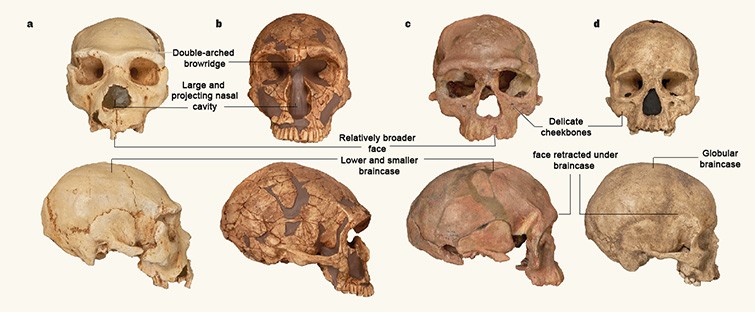The question of who was the first person on Earth has captivated humanity for centuries. This timeless query has inspired religious stories, scientific theories, and philosophical debates. While various cultures and belief systems offer their own explanations, the idea of a single “first person” has sparked curiosity about human origins. In this article, we will dive into the different perspectives that explore who the first person on Earth might have been, focusing on both religious beliefs and scientific discoveries.
Religious Beliefs About the First Person on Earth
Religious stories across the world often present a unique and divine origin for the first person on Earth. In Christianity, Judaism, and Islam, the story of Adam and Eve is central to understanding human creation. According to these Abrahamic faiths, Adam was the first person created by God, with Eve as his companion. This narrative establishes Adam as the father of all humans, with these early figures symbolizing the beginning of human existence. In the Bible, Adam’s creation marks a pivotal moment in history, wherein humans were given free will and the responsibility to care for the Earth.
Similarly, in Islamic teachings, Adam is not only seen as the first human but also the first prophet. His creation in the Islamic faith parallels the Biblical account, though with added emphasis on his role in guiding humanity through divine teachings. These religious beliefs suggest that the first person on Earth, Adam, had a unique and essential purpose, carrying with him the moral and spiritual foundation for human civilization. For believers, these stories offer comfort and meaning, reinforcing the idea that humanity’s origins are part of a larger divine plan.
Scientific View on the First Person on Earth
In contrast to the religious perspective, the scientific view of human origins tells a different story. According to evolutionary biology, the emergence of Homo sapiens—the species to which modern humans belong—was not a single event, but a gradual process that took place over millions of years. Instead of a singular “first person,” human evolution is marked by a continuous transformation of early hominins into the Homo sapiens species. This gradual evolution suggests that the first person on Earth wasn’t a single individual but a group of early humans who shared common traits.
The theory of evolution proposes that early humans evolved from earlier species, such as Homo habilis and Homo erectus, over a long period. Fossil evidence, like that of Omo 1, one of the oldest known Homo sapiens fossils, helps to illuminate the timeline of human evolution. Omo 1, estimated to be about 195,000 years old, provides valuable insight into the characteristics of early Homo sapiens and their way of life. However, Omo 1 wasn’t a lone individual; it was part of a population of early humans, reinforcing the idea that human evolution is a collective, rather than an individual, journey.
Fossil Evidence and the Oldest Humans

The search for fossil evidence plays a crucial role in understanding the question of who was the first person on Earth. Fossils such as Omo 1 represent one of the earliest known examples of Homo sapiens, providing a glimpse into the physical appearance and lifestyle of our ancient ancestors. Discovered in Ethiopia, Omo 1 is one of the oldest Homo sapiens fossils found, dating back nearly 200,000 years. Although it doesn’t represent the “first person” in a strict sense, it does offer essential evidence about the evolution of human beings and their development over time.
In addition to Omo 1, other significant fossil discoveries, such as Lucy—a 3.2-million-year-old Australopithecus afarensis—help trace the evolutionary steps that led to modern humans. These fossils illustrate how early hominins, with their small brains and ape-like features, gradually evolved into species with larger brains and more complex social structures. Fossil records continue to be essential in piecing together the broader picture of human evolution and understanding how Homo sapiens eventually emerged as the dominant species on Earth.
Was There a “First Person” or a Gradual Evolution?
One of the most intriguing aspects of the question “who was the first person on Earth?” is the idea of whether there was truly a single first individual, or if it was a gradual process. Religious stories often speak of a singular Adam as the first human, but from a scientific perspective, human evolution was more gradual. Evolutionary biology supports the idea that Homo sapiens emerged from a population of hominins over a long period of time, with no clear-cut “first person.” The changes that led to the first Homo sapiens were incremental, taking place over many generations.
The gradual nature of human evolution complicates the idea of a singular “first person.” Instead of focusing on one individual, scientists look at the larger picture of how early human populations adapted and evolved over time. Genetic evidence further supports the notion that humanity’s origin was not a single event, but rather a complex process. Modern humans are the result of thousands of small changes that occurred over millennia, each step bringing us closer to the Homo sapiens we are today.
The Role of God in the Creation of the First Human
In religious traditions, God is often seen as the creator of the first person on Earth. This belief is central to many faiths, particularly in the Abrahamic religions of Christianity, Judaism, and Islam. According to these traditions, Adam, the first human, was created by God in His image and given a divine purpose. This creation myth provides a framework for understanding human origins and the moral responsibilities that come with being human. For many believers, the question of who was the first person on Earth is intertwined with their faith in God as the Creator of all life.
From a theological perspective, God’s role in creating the first human is not only about the physical formation of Adam but also about instilling humanity with purpose, knowledge, and free will. The creation of the first human symbolizes the beginning of human history, in which humans are tasked with stewarding the Earth. While science offers a different explanation for human origins, for those who follow religious beliefs, God’s involvement in creating the first person is a foundational part of their understanding of life and existence.
Conclusion
The question of who was the first person on Earth is a multifaceted one, with both religious and scientific perspectives offering valuable insights. From a religious standpoint, the first person is often seen as a divine creation, such as Adam in the Bible or in Islamic teachings. These stories provide spiritual guidance and a sense of purpose for believers. On the other hand, the scientific perspective highlights the gradual evolution of humans from earlier hominins, with fossil evidence pointing to the emergence of Homo sapiens over millions of years. While the concept of a “first person” may be complex, both views contribute to our understanding of human origins and our place in the world.
FAQs
- Who was the first person on Earth according to science?
- Scientific evidence suggests that Homo sapiens evolved over time from earlier hominins, such as Homo habilis and Homo erectus. The emergence of Homo sapiens was gradual, with no single “first person.”
- Scientific evidence suggests that Homo sapiens evolved over time from earlier hominins, such as Homo habilis and Homo erectus. The emergence of Homo sapiens was gradual, with no single “first person.”
- Was Adam the first person on Earth?
- In religious beliefs, Adam is considered the first person created by God, especially in Christianity, Judaism, and Islam. These traditions see Adam as the ancestor of all humans.
- In religious beliefs, Adam is considered the first person created by God, especially in Christianity, Judaism, and Islam. These traditions see Adam as the ancestor of all humans.
- Who was the first person to die on Earth?
- The first death likely occurred within early human populations, long before the advent of modern humans. It was part of the natural process of life and evolution.
- The first death likely occurred within early human populations, long before the advent of modern humans. It was part of the natural process of life and evolution.
- Who was the first person on Earth in the Bible?
- According to the Bible, Adam was the first human created by God. He was placed in the Garden of Eden with Eve, who was created as his companion.
- According to the Bible, Adam was the first human created by God. He was placed in the Garden of Eden with Eve, who was created as his companion.
- How did humans evolve into the first person?
- Humans evolved gradually from earlier species through small changes in anatomy and behavior over millions of years, leading to the modern Homo sapiens.
- Humans evolved gradually from earlier species through small changes in anatomy and behavior over millions of years, leading to the modern Homo sapiens.
- Was there a “first person” or was it a gradual evolution?
- From a scientific viewpoint, human evolution was gradual, and there wasn’t a singular “first person.” Homo sapiens emerged as part of a population that evolved over time.
- From a scientific viewpoint, human evolution was gradual, and there wasn’t a singular “first person.” Homo sapiens emerged as part of a population that evolved over time.
- What does science say about the first person on Earth?
- Science explains that Homo sapiens evolved from earlier species over millions of years, with no clear-cut “first person.” Fossils and genetic evidence support this gradual process.
- Science explains that Homo sapiens evolved from earlier species over millions of years, with no clear-cut “first person.” Fossils and genetic evidence support this gradual process.
- Who were the first humans after the dinosaurs?
- The first humans appeared millions of years after the dinosaurs, with early human ancestors evolving into Homo sapiens over time.
You may also read: What Will Happen to Earth in 2025 with the Sun?


